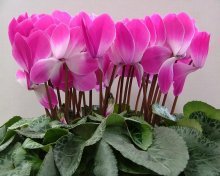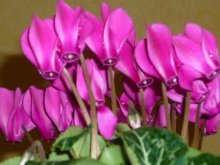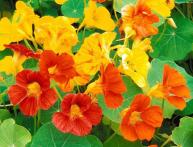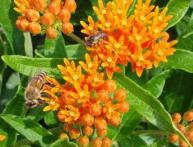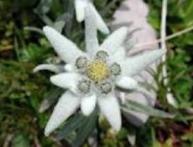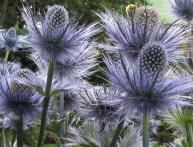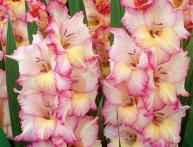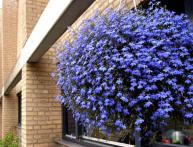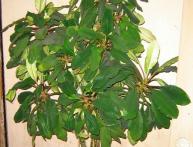Cyclamen: caring for it at home, growing and propagating
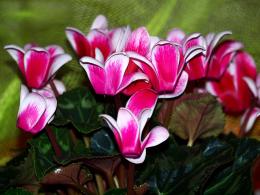
Cyclamen is a beautiful flowering indoor plant from the Primrose family. About 15 species will grow in natural conditions. Only 2 are used as indoor crops: Persian cyclamen and European. The main difference between these species is only in the timing of flowering. The Persian flowering period is in winter, and the European flowering period is in spring and summer.
Content
Description of the plant
Cyclamen - a popular indoor plant with a tuberous root. It has heart-shaped basal leaves with a silvery pattern, which are located on long petioles. The flowers are shaped like butterflies; their petals are bent back and pointed. Depending on the variety, the edges of the petals may be fringed or smooth. The color of the flowers can be very diverse, from white to deep burgundy.
With proper care, the flowering period of cyclamen lasts about 3 months. The tuber of this plant has a flattened shape, its diameter is about 15 cm. It has only one growth point, if it is damaged, the plant will certainly die.
Growing conditions
Cyclamen is often considered a very demanding and capricious plant, but this is absolutely not the case. This culture is quite unpretentious and does not require any special care or growing conditions.
It is best to place a pot of cyclamen in a place with bright but diffuse lighting. For this purpose, windows with eastern or western exposure are best suited. In summer, a pot of cyclamen can be placed on a north window, where it will be reliably protected from direct sunlight.
In winter, the optimal temperature for cyclamen is considered to be within +12-14°C. The plant reacts negatively to higher rates. Advice! To reduce the negative impact of high temperature on cyclamen, it must be sprayed with cool water daily. In this case, you need to ensure that it does not fall on the growing point and flowers.
For growing For cyclamen, a loose substrate with a slightly acidic reaction is suitable. It can be made from 3 parts leaf humus, 1 part peat, 1 part sand. You can also use ready-made flower soil.
During the active growing season, which for cyclamen lasts from September to March, the plant needs to be watered abundantly. In this case, it is best to use bottom watering, that is, the pot with the plant is placed on a tray of water. There it is left until the top layer of soil becomes wet, after which the excess moisture is drained from the pan.
Proper care

Caring for cyclamen is quite simple. The main thing is to adhere to the following simple rules:
- Although this culture requires cool conditions, it reacts negatively to drafts. Therefore, they should not be allowed in the room where the cyclamen is located.
- During the period of active growth, the plant must be fed. To do this, you can use any complex fertilizer for indoor plants. It should be diluted according to the attached instructions.
- Cyclamen requires high air humidity, so the air around it should be periodically spray.
Also, faded flowers must be constantly removed from the plant. If this is not done, the bases of the flower stalks begin to rot, which will most likely lead to the death of the entire plant. Moreover, the flower stalks should not be cut or pulled out, but carefully twisted.
Rest period
After flowering ends, cyclamen enters a dormant period and by the beginning of summer there are no leaves left on the plant. A sign of the onset of this period is yellowing of the leaves. After this, watering begins to be reduced, gradually bringing it to a minimum.
Attention! The soil in the pot should not be allowed to dry out completely; it should be watered occasionally. Since the roots of the plant do not die, but remain alive. If these conditions are met, by the beginning of August the cyclamen wakes up and begins to grow new leaves. After which the tuber must be transplanted into fresh soil.
Reproduction of cyclamen
Reproduce Cyclamen can be grown either vegetatively, that is, by dividing the tuber, or by seeds. Each of these methods has its own advantages and disadvantages.
All the secrets of caring for cyclamen on video:
Tuber division
This propagation method can only be used on adult and large tubers. The procedure in this case is as follows:
- Rinse the tuber from any remaining soil.
- Using a sharp knife, cut into pieces, each of which should have a growth point.
- Sprinkle the sections with crushed charcoal powder.
- Dry the cuttings for several days.
- Plant in the ground, deepening no more than two-thirds.
When breeding dividing the tuber Flowering plants can be obtained already in the same year.
Seed propagation
Cyclamen can also be propagated by sowing seeds. To do this, seed containers are prepared in February and filled with loose and moisture-absorbing soil. To increase the percentage of seed germination before sowing, they can be treated with growth stimulants. For example, the following drugs give good results:
- Epin
- Zircon
- Rostock
- Heteroauxin
The sowing depth should be no more than 1 cm. The seeds can be laid out either in rows or in random order, and the distance between them should be at least 2 cm. After which they are sealed with a very thin layer of soil or lightly sprinkled with sand.
After sowing is completed, the containers are covered with film, preferably dark, and placed in a warm place. The optimal temperature for germination should be about +20°C. If all these conditions are met, the first shoots will be visible in 50-60 days.
But these terms are arbitrary, as there are varieties whose seeds can germinate up to 5 months. Attention! At first, the seedlings do not yet have leaves; they look like small peas with one root.
At this time, it is very important to prevent the soil from drying out. Immediately after the first seedlings appear, the seed containers are moved to a well-lit place. After some time, the first pair of leaves will appear on the young plants, after which you can begin to plant them. picking. With proper care, plants grown from seeds bloom in 7-11 months.
Plant pests
Most often you can find the following types of pests on cyclamen:
- Aphid
- Thrips
- Mite
Aphid. Small insects that feed on plant juices. In most cases, aphid colonies prefer to settle on young buds and shoots of cyclamen.The first sign of this pest is curled leaves. Systemic insecticides are used to kill aphids.
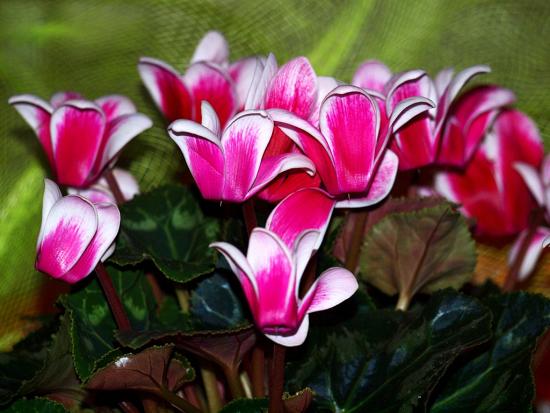
Thrips. They appear most often at high air temperatures and low humidity. Just like aphids, they feed on plant sap. This pest is destroyed with insecticides. Cyclamen mite. Very small, almost microscopic pest, which settles on the reverse side of the leaf blades.
The leaves of the affected plant begin to curl and the buds die before they even have time to bloom. The cyclamen mite is destroyed with insecticidal preparations. When creating suitable growing conditions and proper care, cyclamen can actively bloom and develop for 10 years or more.

